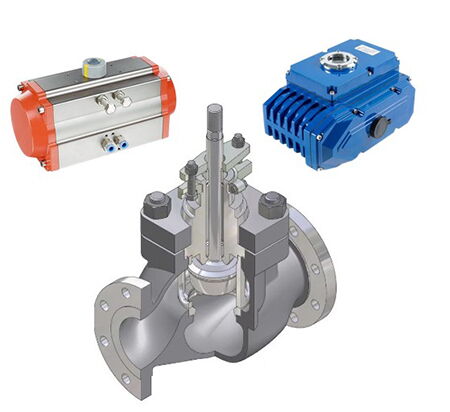Position Control in Electric and Pneumatic Control Valves
On this page
In industrial automation and process control, the choice of control valves directly impacts the efficiency, accuracy, and reliability of the system. Among the various types, electric control valves and pneumatic control valves are common actuator types, each with unique characteristics and applicable scenarios for position control. This article will comprehensively explore the position control of electric control valves and pneumatic control valves, analyzing their working principles, structural features, application scenarios, and economic considerations to assist engineers and owners in making the best choice for their specific applications.
The position control of electric control valves is crucial in industrial automation, ensuring stable system operation under varying conditions through precise adjustments. Below, we delve into the working principles, feedback mechanisms, and application scenarios of electric control valves to provide a comprehensive understanding of their control advantages.
Electric control valves rely on an electric motor as the driving force, achieving precise position control through a stepper PID controller. The stepper PID controller measures the difference between the set value and the actual value, calculates the required adjustment for the valve position, and outputs a pulse signal to drive the motor's rotation, adjusting the valve's position. This control method allows for high-precision adjustments, meeting the stringent requirements for position control in complex processes.
Based on the type of position feedback, electric control valves can be categorized as follows:
Without Position Feedback: Provides simple control for fully open or fully closed states, suitable for applications where position accuracy is not critical.
Two-Position Feedback: Offers feedback on open or closed status but does not provide continuous position information.
Continuous Position Feedback: Continuously provides real-time feedback on the valve's position, ideal for high-precision control systems.
While electric control valves with continuous position feedback excel in control accuracy, they are relatively expensive and are typically used in applications with stringent control precision requirements. In other cases, external devices can be added to compensate for the lack of position feedback, enabling continuous position control.
Electric control valves are widely used in industries such as paper manufacturing, petrochemicals, power plants, and refrigeration, especially in scenarios requiring high-precision control, such as flow regulation, pressure control, and temperature management. They are simple to install, have low failure rates, and require minimal maintenance, making them indispensable components in industrial automation.
Pneumatic control valve position control primarily depends on the operation of pneumatic actuators, regulating air pressure to achieve valve opening, closing, and flow control. Compared to electric control valves, pneumatic control valves offer faster response times, making them suitable for applications requiring frequent switching and rapid response.
Pneumatic control valves use compressed air to drive pneumatic actuators and cylinders, enabling valve opening and closing. The pneumatic actuator converts air pressure into mechanical motion, thereby adjusting the valve position. Pneumatic control valves have fast response times, making them ideal for applications requiring quick switching. However, the non-linear characteristics of pneumatic systems and the compressibility of air present challenges in fine position adjustment and maintaining stable positions.
Pneumatic control valves typically do not have inherent continuous position feedback functions but can achieve position control and feedback through external positioners or other control systems. Compared to electric control valves, pneumatic control valves require more auxiliary equipment and tuning in complex control systems, potentially increasing system complexity and maintenance costs.
Pneumatic control valves are widely used in industries such as chemicals, petroleum, natural gas, and water treatment, particularly in applications requiring quick response and reliable switching actions, such as emergency shutdowns, fast switching, and safety interlocks. Pneumatic control valves are simple in structure and reliable in operation, performing well even in harsh environments.
The structural design of valves directly influences their position control performance and applicability. The following are some common valve structures and their impact on position control.
Plug Valves utilize a plug sealed within a conical body, rotating the plug to open and close the valve. This simple design is suitable for on-off control but performs moderately in precise position control.
The disc is fixed to a central shaft, and rotating the disc regulates fluid flow. Butterfly valves offer good position control, especially in large-diameter pipelines, but their control accuracy is limited by the mechanical structure.
Ball Valves control fluid flow by rotating a spherical element, providing excellent sealing performance. The floating ball structure can achieve effective sealing under high differential pressures, but improvements are still needed in continuous position feedback and adjustment accuracy.
In industrial automation and process control, electric control valves and pneumatic control valves each offer unique advantages and challenges. Electric control valves excel in position control accuracy and feedback functionality, making them suitable for applications with high precision and complex control requirements. Pneumatic control valves, known for their quick response and simple control, are ideal for situations requiring rapid switching. In practice, engineers should consider control accuracy, response speed, system complexity, and economic factors when selecting the most appropriate valve type to optimize system performance and reduce overall costs.

